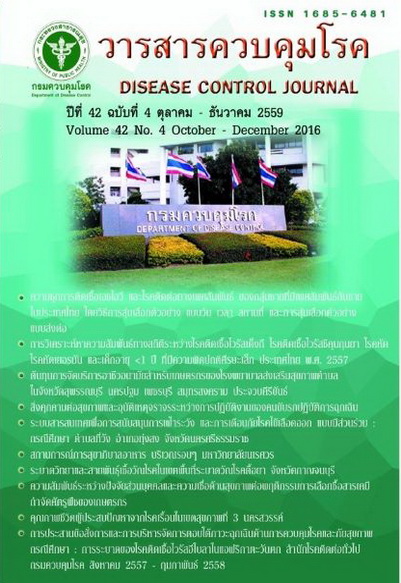Situation of food sanitation in the area around Naresuan University Phitsanulok Province Thailand
DOI:
https://doi.org/10.14456/dcj.2016.6Keywords:
food sanitation, Coliform bacteria, foodAbstract
This cross sectional study was conducted in order to evaluate the situation of food sanitation in Thai street food stalls in the area around Naresuan University in Phitsanulok Province Thailand. A sample consist¬ing of 88 food stalls was collected and evaluated using an assessment checklist and by gathering data on contamination using coliform bacteria test kits (SI-2) on food samples, kitchen utensils and food handlers. A set of data to analysis was conducted using descriptive statistic frequencies and percentages. Results showed that there was only 1 food stall that passed the physical standard evaluated by the questionnaire assessment focusing on 3 top criteria. The first criteria, entitled item No 12 which states that cooks should be wearing clean clothes, shirts with sleeves, clean aprons and a hat or hair net. The second criteria, item No 10, states that food stalls should have good sanitary waste and water disposal. And The third criteria, item No 8, states that knife, cutting board should be separated between cook meat, raw meat and raw vegetables. There were 4 food stalls that passed biological standard as follow, one-dish-meal food stall, one rice-and-curry food stall and 2 cook-as-ordered food stalls. The contaminated samples were mostly found on food handlers (54.0%), kitchen utensils (49.0%) and in food samples (15.9%). The most common kitchen utensil where coliform bacteria was found are bowls (67.4%) and the most common food type where coliform bacteria was found was in the cultural food of the Northeast (25.0%). This study shows that food sanitation is important to make sure that food is free from disease and demonstrates that improvements should be focused in the future.
Downloads
References
2. ปรีญา ริมดุสิต. ความรู้เกี่ยวกับสุขภาพอนามัย. กรุงเทพมหานคร: ทิพยวิสุทธิ์; 2542.
3. ศิวาพร ศิวเวชช. การสุขาภิบาลโรงงานอุตสาหกรรมอาหาร. นครปฐม: ศูนย์ส่งเสริมและฝึกอบรมการเกษตรแห่งชาติ มหาวิทยาลัยเกษตรศาสตร์ วิทยาเขตกําแพงแสน; 2542.
4. อรศรี ผลถาวร. ปัจจัยที่มีความสัมพันธ์กับสภาวะสุขาภิบาลของร้านจำหน่ายอาหารในเขตหลักสี่ [วิทยานิพนธ์ปริญญาสาธารณสุขศาสตรมหาบัณฑิต]. กรุงเทพมหานคร: มหาวิทยาลัยธรรมศาสตร์; 2554.
5. เพ็ญนภา พร้อมพิมพ์. ความสัมพันธ์ระหว่างความรู้และการปฏิบัติตามหลักสุขาภิบาลอาหารของร้านจำหน่ายอาหารกับคุณภาพทางแบคทีเรียของอาหารที่จัดจำหน่าย ภาชนะ และมือผู้สัมผัสอาหาร ในอำเภอกระสัง จังหวัดบุรีรัมย์ [วิทยานิพนธ์ปริญญาสาธารณสุขศาสตรมหาบัณฑิต]. สุรินทร์: มหาวิทยาลัยราชภัฏสุรินทร์; 2555.
6. นฤมล วีระพันธ์, ปราณี ทองคำ. ปัจจัยที่มีผลต่อสภาวะการสุขาภิบาลอาหารตามหลักเกณฑ์ข้อกำหนดมาตรฐานของร้านอาหารในเขตอำเภอเมือง จังหวัดปัตตานี. วารสารสงขลานครินทร์ ฉบับสังคมศาสตร์และมนุษยศาสตร์ 2550;13:187- 200.
7. พงษ์พจน์ เปี้ยน้ำล้อม, วันเพ็ญ ถาวรโชติ, อนุ เอี่ยมทอง. สภาวะการสุขาภิบาลอาหารและความสัมพันธ์ระหว่างปัจจัยที่มีผลต่อการปนเปื้อนเชื้อโคลิฟอร์มแบคทีเรียในร้านอาหาร กรณีศึกษา : ชุมชนรอบมหาวิทยาลัยนเรศวร จังหวัดพิษณุโลก [การศึกษาค้นคว้าด้วยตนเองวิทยาศาสตรมหาบัณฑิต]. พิษณุโลก: มหาวิทยาลัยนเรศวร; 2546.
8. อภิชาติ น้อยถนอม. ปัจจัยที่มีความสัมพันธ์กับสภาพสุขาภิบาลอาหารของร้านจำหน่ายอาหารตามสั่งบริเวณหาดเจ้าหลาว-แหลมเสด็จ อำเภอท่าใหม่ จังหวัดจันทบุรี [วิทยานิพนธ์ปริญญาสาธารณสุขศาสตรมหาบัณฑิต]. ชลบุรี: มหาวิทยาลัยบูรพา; 2546.
9. มณฑิรา มูลศรี. สถานการณ์สุขาภิบาลอาหารของโรงอาหารในมหาวิทยาลัยขอนแก่น [วิทยานิพนธ์ปริญญาสาธารณสุขศาสตรมหาบัณฑิต]. ขอนแก่น: มหาวิทยาลัยขอนแก่น; 2557.
10. กองสุขาภิบาลอาหาร. คู่มือวิชาการสุขาภิบาลอาหารสำหรับเจ้าหน้าที่. กรุงเทพมหานคร: กรมอนามัย กระทรวงสาธารณสุข; 2556.
Downloads
Published
How to Cite
Issue
Section
License
Articles published in the Disease Control Journal are considered as academic work, research or analysis of the personal opinion of the authors, not the opinion of the Thailand Department of Disease Control or editorial team. The authors must be responsible for their articles.






